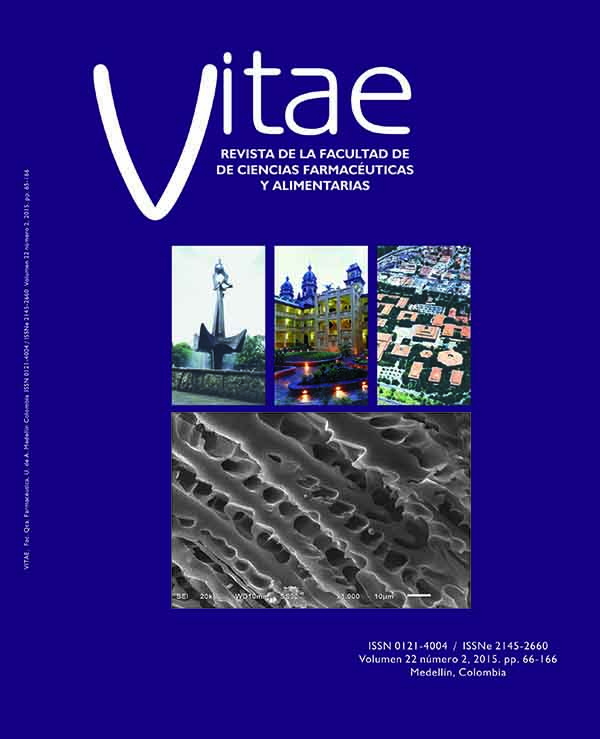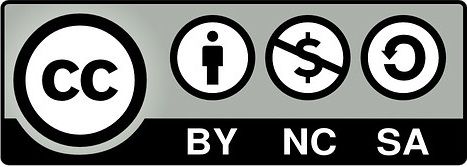Estudio del proceso de clarificación de hidrolizados de almidón de yuca utilizando membranas cerámicas
DOI:
https://doi.org/10.17533/udea.vitae.v22n2a06Keywords:
Filtración, membranas, hidrolizado, almidón, yucaAbstract
Antecedentes: La etapa de clarificación de hidrolizados de almidón para la producción de jarabes de glucosa es la principal causa de su producción por lotes, además de acarrear altos costos al utilizar filtros rotatorios al vacío, carbón activado y tierras diatomeas que aseguren la calidad del producto. Objetivos: Evaluar la etapa de clarificación de hidrolizados de almidón de yuca obtenidos por vía enzimática utilizando tecnología con membranas, a diferentes temperaturas, diámetros de poro de membrana y presiones transmembrana. Métodos: La clarificación se realizó utilizando un piloto compuesto por un tanque enchaquetado, donde se llevó a cabo la reacción de hidrólisis. La filtración se realizaba conectando el tanque a una bomba que permitía enviar el fluido al módulo membranario; la presión transmembrana fue fijada con una válvula a la salida del módulo. Los experimentos se llevaron a cabo usando membranas con diferentes tamaños de poro en un diseño factorial 22, evaluando dos niveles de temperatura (50 y 70ºC) y dos niveles de presión transmembrana (0,15 y 0,30 MPa). Se midieron los caudales obtenidos para el retenido y el permeado. Las muestras obtenidas fueron analizadas para evaluar la calidad del permeado (turbidez, cantidad de proteína retenida, contenido de materia seca y ºBrix). El análisis estadístico se llevó a cabo con el software Statgraphic Centurion XVI.I®. Resultados: Los resultados obtenidos mostraron que las presiones transmembrana (0,15 y 0,30 MPa) y temperaturas (50 y 70 ºC) evaluadas no influyen significativamente sobre la permeabilidad ni calidad del permeado (p-valores > 0,05) permitiendo trabajar con la menor presión tranmembrana (menor desgaste de equipos y menor gasto energético), y a la temperatura de hidrólisis, lo cual permitiría trabajar bajo condiciones de producción en continuo. Además, se observó que es posible utilizar membranas con diámetro de poro de hasta 0,8 μm; aumentado hasta en 5 veces la productividad y disminuyendo la turbidez en un 99%. Conclusiones: Es posible utilizar membranas cerámicas de microfiltración de hasta 0,8 μm, en condiciones moderadas de presión transmembrana y a la temperatura de hidrólisis para la clarificación de hidrolizados de almidón de yuca sin disminuir la calidad del permeado.
Downloads
References
Hobbs L. Sweeteners from starch; production, properties and uses. Starch: Chemistry and technology. 2009;799-821.
Uribe JP. Obtencion de jarabe fructosado a partir de almidon de platano [Tesis]. Morelos, México: Instituto Politecnico Nacional; 2004.
Arango M. Jarabes de Maiz. Revista de Alimentos.2008;22.
Promitec. Promitec soluciones biotecnologicas naturales (sitio en internet). Promitec S.A.S. Disponible en:http://promitec.com.co/ images/documentos/192Ficha%20t%C3%A9cnica%20Jarabe%20 de%20Glucosa%20-%20Nat%20Bio%20080.pdf. Acceso el 25 de Agosto 2012.
Tate & Lyle. Tate & Lyle Home (sitio en internet). Disponible en: http://www.tateandlyle.co.uk/NR/rdonlyres/et5lc6vlrt6ftayeubuywmqlxnyd65dcpe3v7fzp6muzg6awn5kseo5gzullqfrgol6vgzketyee3pguit2bwjbgzbb/Espanol_Edulcorantes_Liquid.pdf. Acceso el 28 de Julio 2012.
Kearsley MW, Dziedzic SZ. Handbook of starch hydrolysis products and their derivates. Londres: Blackie Academic & Professional; 1995.
Aya WA, Pineda J, Sanchez O, Cardona C. Análisis comparativo de diferentes materias primas amiláceas para la obtención de alcohol carburante. 2006. Memorias del congreso Colombiano de Ingenierìa Quìmica, ISSN: 1692-925X.
Singh N, Cheryan M. (1998). Properties and Composition of Concentrates and Syrup Obtained by Microfiltration of saccharified Com Starch Hydrolysate. J Cereal Sci. 27:315-320.
Henrissat. A classification of glycosyl hydrolases based on aminoacid sequence similarities. Biochemical. 1991; 309-316.
Acosta. J., Rios, S. Aplicación de las técnicas con membranas de microfiltración y ultrafiltración para la clarificación y fraccionamiento de sangre de bovino cruda e hidrolizada. Tesis para optar al título de Ingeniero Químico. Universidad Industrial de Santander. Bucaramanga. 2013.
Downloads
Published
How to Cite
Issue
Section
License
Copyright Notice and Open Access Statement
The Journal Vitae works under the Open Access license, and the published manuscripts remain available for the public, both on the Journal's website and in databases, under the Creative Commons license, "Noncommercial Attribution" and "Share alike" systems, adopted in Colombia. Hence, when the authors agree to publish in the Journal Vitae, they will not have the right to economic retributions on publications and reproductions through different diffusion media. The documents are freely available to the internet public, permitting users to read, download, copy, distribute, print, search, or link to the full texts and pass them as data to software. The only constraint on reproduction and distribution, should be to give authors control over the integrity of their work and the right to be appropriately acknowledged and cited.
Authors declare that:
-
They are the intellectual property owners and are responsible for all the information stated in the article.
-
This manuscript has not been submitted or published in other printed or digital media. They accept the responsibility for the judgments, opinions, and points of view expressed in the published article and, therefore, they exonerate Universidad de Antioquia and Journal Vitae from any process.
-
They exempt Universidad de Antioquia and Journal Vitae from settling conflicts or disputes related to the authorship of the referred article.
-
They accept the revision of the original manuscript by suitable personnel, and they bind themselves to perform the corrections appointed or suggested by the assessors.
-
Therefore, they know the editorial process and will not bind the Editorial Board of the Journal to assume any obligations regarding the volume and issue in which the article is published.
-
They transfer the rights of publication, reprinting, and distribution of the article from the moment of its approval, in print and digital format, without the right to economic rewards, and under the licensing conditions considered relevant by Journal Vitae.
-
They fully authorize Universidad de Antioquia and Journal Vitae to submit the published material to the diverse databases and indexing systems where the Journal can be found to comply with the requirements of the regulatory authorities to maintain the national classification of journals.
-
They will assume the article publication costs established for the current issue, and they will make the payment as soon as they are informed about the volume and the issue in which the final version of the article is published.
-
After the article is published, you can share digital or printed copies in a noncommercial manner. You will be able to use the paper in your institution or company for educational or research purposes, including the use in course programs.
Conflict of interest: Authors are responsible for recognizing and disclosing any financial or other benefits that could be perceived to bias their work, acknowledging all financial support and any personal connections with potential sponsors. Examples of such conflicts include receiving research funds or honoraria, serving on advisory boards, stock ownership, or employment and consulting arrangements. Authors without such connections should clearly state that they have no financial support or personal relationships that could be perceived to bias their work. All conflicts of interest should be disclosed on the author's identification page of the manuscript.










